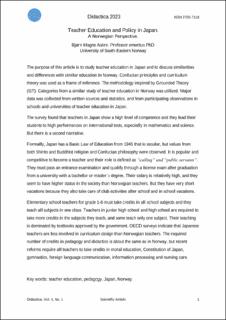| dc.contributor.author | Aakre, Bjørn Magne | |
| dc.date.accessioned | 2023-05-31T08:50:07Z | |
| dc.date.available | 2023-05-31T08:50:07Z | |
| dc.date.created | 2023-02-14T09:20:01Z | |
| dc.date.issued | 2023 | |
| dc.identifier.citation | Aakre, B. M. (2023). Teacher Education and Policy in Japan. A Norwegian Perspective. Didactica, 4(1), 1-36. | en_US |
| dc.identifier.issn | 2703-7118 | |
| dc.identifier.uri | https://hdl.handle.net/11250/3069431 | |
| dc.description.abstract | The purpose of this article is to study teacher education in Japan and to discuss similarities and differences with similar education in Norway. Confucian principles and curriculum theory was used as a frame of reference. The methodology inspired by Grounded Theory (GT). Categories from a similar study of teacher education in Norway was utilized. Major data was collected from written sources and statistics, and from participating observations in schools and universities of teacher education in Japan.
The survey found that teachers in Japan show a high level of competence and they lead their students to high performances on international tests, especially in mathematics and science. But there is a second narrative.
Formally, Japan has a Basic Law of Education from 1945 that is secular, but values from both Shinto and Buddhist religion and Confucian philosophy were observed. It is popular and competitive to become a teacher and their role is defined as “calling” and “public servants”. They must pass an entrance examination and qualify through a license exam after graduation from a university with a bachelor or master’s degree. Their salary is relatively high, and they seem to have higher status in the society than Norwegian teachers. But they have very short vacations because they also take care of club activities after school and in school vacations.
Elementary school teachers for grade 1-6 must take credits in all school subjects and they teach all subjects in one class. Teachers in junior high school and high school are required to take more credits in the subjects they teach, and some teach only one subject. Their teaching is dominated by textbooks approved by the government. OECD surveys indicate that Japanese teachers are less involved in curriculum design than Norwegian teachers. The required number of credits in pedagogy and didactics is about the same as in Norway, but recent reforms require all teachers to take credits in moral education, Constitution of Japan, gymnastics, foreign language communication, information processing and nursing care. | en_US |
| dc.language.iso | eng | en_US |
| dc.relation.uri | https://didactica.one/2023/Teacher%20Education%20and%20Policy%20in%20Japan.pdf | |
| dc.relation.uri | https://didactica.one/index.htm | |
| dc.subject | Komparativ forskning | en_US |
| dc.subject | Comparative research | en_US |
| dc.subject | Pedagogikk | en_US |
| dc.subject | Pedagogy | en_US |
| dc.subject | Profesjonspedagogikk | en_US |
| dc.subject | Professional pedagogy | en_US |
| dc.subject | Lærerutdanning | en_US |
| dc.subject | Teacher education | en_US |
| dc.title | Teacher Education and Policy in Japan. A Norwegian Perspective | en_US |
| dc.title.alternative | Teacher Education and Policy in Japan | en_US |
| dc.type | Journal article | en_US |
| dc.description.version | publishedVersion | en_US |
| dc.subject.nsi | VDP::Pedagogiske fag: 280 | en_US |
| dc.subject.nsi | VDP::Education: 280 | en_US |
| dc.source.pagenumber | 1-36 | en_US |
| dc.source.volume | 4 | en_US |
| dc.source.journal | Didactica | en_US |
| dc.source.issue | 1 | en_US |
| dc.identifier.cristin | 2125836 | |
| cristin.ispublished | true | |
| cristin.fulltext | original | |
| cristin.fulltext | original | |
